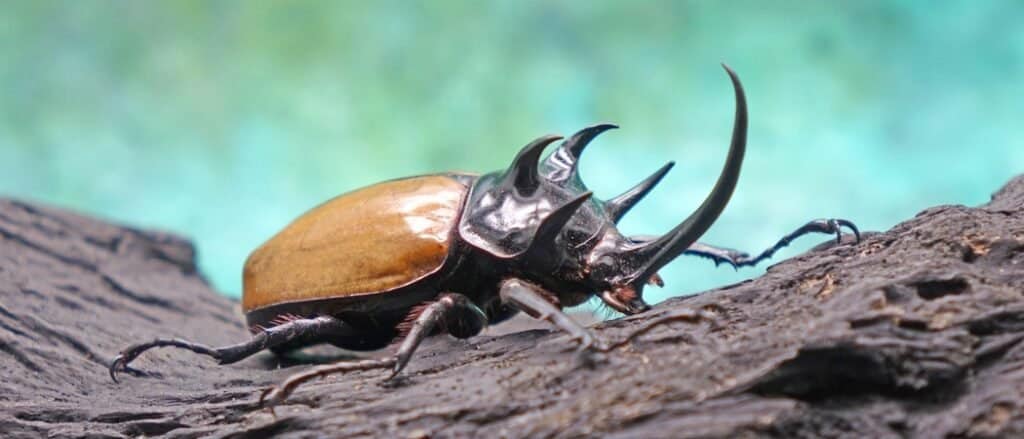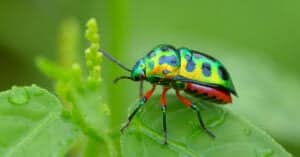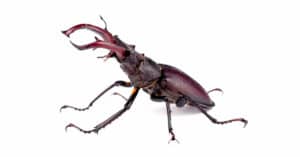Over 400,000 species of beetles have been identified, and it’s estimated that over a million exist. Among the largest subfamilies of beetles include the Dynastinae, also called the rhinoceros beetle. The largest of the rhinoceros beetles is the Hercules beetle, a beetle with monstrous size. Today, we’re going to look at the Hercules beetle vs. rhinoceros beetle to see how the Hercules beetle is distinct from the rest of the family.
Comparing Hercules Beetle vs. Rhinoceros Beetle
| Hercules Beetle | Rhinoceros Beetle | |
|---|---|---|
| Size | Weight: 0.50-1.2 ounces Length: 2.4 to 3 inches, up to 7 inches including horn | Weight: 0.2-1.2 ounces Length: 0.5-3 inches, up to 7 inches counting the Hercules beetle |
| Morphology | – The largest extant beetle – Horn-like pincers on its head, but only on males – Powerful body allows them to lift between 80 and 100 times their weight or more – Strong exoskeleton – Frequently black, yellow, and green in color – Tough forewings with membranous hindwings – Cylindrical body | – Many species have sizable horns used to battle other males – Some species have longer horns than others, including the Hercules beetle and Japanese rhinoceros beetle – Most are black, green, gray, or yellow – Cylindrical body – Have a hard exoskeleton – Have chitinous forewings with membranous hindwings |
| Diet | – Herbivorous – Consume fruit and rotting wood, especially tropical fruits | – Herbivorous – Rotten wood, tree sap, nectar, and some types of fruit – Larvae prefer rotting wood |
| Species | – Dynastes hercules – Roughly 10 subspecies have been identified | – Dynastinae subfamily of Scarabaeidae, the scarab beetle family – 1500 species and 225 genera of rhinoceros beetles exist – Includes the Hercules beetle |
| Range and Habitat | – Central and South America along with the West Indies – Includes countries like Mexico, Bolivia, Brazil, Colombia, Peru, Trinidad and Tobago, and more – Prefer to live in rainforests | – Every continent except Antarctica – Live in a variety of habitats like woodlands, grasslands, and farms – Often nest in rotting wood – Many species are popular pets in Asia |
The 5 Key Differences Between Hercules Beetles Rhinoceros Beetles

Hercules beetles are the largest living species of beetle and can be 7 inches long, including their horn
©feathercollector/Shutterstock.com
The greatest differences between a Hercules beetle and a rhinoceros beetle can be found in their average size, location, and morphology. Hercules beetles are the largest extant species of beetle, and they grow between 2.4 and 3 inches long in body length and 7 inches overall when you include their massive horn. Rhinoceros beetles, excluding the Hercules beetle, average up to 3 inches in total length.
Rhinoceros beetles are found on every continent except Antarctica, but Hercules beetles are only found in Central and South America as well as the nearby islands comprising the West Indies.
Male Hercules beetles have massive, pincer-like horns that they use to battle other males for access to females. While many other rhinoceros beetles have sizable horns, like the Japanese Rhinoceros beetle, none have horns that are as long as the Hercules beetle.
These are some of the greatest differences between the Hercules beetle species and the entire subfamily to which it belongs. However, other unique qualities exist too. We’re going to look a bit closer at five different ways that they’re different.
Hercules Beetle vs. Rhinoceros Beetle: Size
While many rhinoceros beetles are large, the Hercules beetle is the largest of them all. The average Hercules beetle weighs 0.5 to 1.2 ounces and measures between 2.4 and 3 inches, the former for females and the latter for males. However, the males are far longer due to their horn, which measures several inches. The longest Hercules beetles are between 6 and 7 inches long.
Meanwhile, the average Rhinocerous beetle measures between 0.2 and 1.2 ounces and measures from 0.5 inches long to 3 inches. This measure includes several of the largest beetles and their horns, like the Japanese rhinoceros beetle. However, several variations of body size exist in this subfamily.
Hercules Beetle vs. Rhinoceros Beetle: Morphology
The rhinoceros beetles and Hercules beetles are known for their large horns. However, the Hercules beetle has a horn that can exceed 1/3 of its total body length. This horn-like pincer is only found in males, and it can be quite massive. This piece of anatomy helps the Hercules beetle lift about 100 times its own weight!
Other male rhinoceros beetles have horns, and not all of them have the elongated overarching curve. Some are smaller and resemble the rhinos for which they’re named. Moreover, the colors of the rhinoceros beetles are common in Hercules beetles, especially black, yellow, and green.
Both types of beetles have hard exoskeletons, chitinous forewings, and membranous hindwings. Still, the Hercules beetle is larger than the others and is one of the largest flying insects.
Hercules Beetle vs. Rhinoceros Beetle: Diet
The Hercules beetle and most other rhinoceros beetles have a similar diet. They’re herbivores that survive on rotting wood in their long, ravenous larval stage and are fruit-eaters as adults. Due to their variation in range, though, they don’t eat all the same fruits.
Hercules beetles are known for consuming tropical fruits like mangoes, something that not all the members of the rhinoceros beetle subfamily can access. Thus, their diet is somewhat unique to many other members of the rhinoceros beetle family.
Hercules Beetle vs Rhinoceros Beetle: Species
The Hercules beetle comes from the Dynastinae subfamily, a branch of the Scarabaeidae family. The species name is Dynastes hercules, and roughly ten different species belong to the Dynastes genus. Meanwhile, the Dynastinae subfamily that contains all rhinoceros beetles is home to 1,500 species from 225 genera. To be clear, the Hercules beetle is a rhinoceros beetle.
Hercules Beetle vs. Rhinoceros Beetle: Range and Habitat

Rhinoceros beetles are found on every continent except Antarctica where they live in habitats such as forests and grasslands.
©Mark Brandon/Shutterstock.com
Hercules beetles live in Central America and South America, including countries like Mexico, Bolivia, Brazil, Peru, and Trinidad and Tobago. They can often be found living in rainforests, but they are losing area due to deforestation.
Meanwhile, rhinoceros beetles can be found on every continent except Antarctica. They live in woodlands, grasslands, farmlands, and forests. They often make their homes in rotting wood, especially as larvae. Sometimes, the adult versions of these creatures are kept as pets in parts of Asia.
All in all, the Hercules beetle is an exceptional species of rhinoceros beetle. They are certainly unique due to their size and morphology. However, they aren’t the only interesting species to come from that family!
Up Next:
- Cigarette Beetle vs Drugstore Beetle: What are the Differences?
- Click Beetle vs Cockroach: What are the Differences?
- Carpet Beetle vs Bed Bug: What are the Differences?
- Stag Beetle vs. Hercules Beetle — An Epic Beetle Battle
The photo featured at the top of this post is © feathercollector/Shutterstock.com
Sources
- Natural History Museum, Available here: https://www.nhm.ac.uk/discover/what-is-the-biggest-beetle-in-the-world.html
- National Wildlife Federation, Available here: https://www.nwf.org/Educational-Resources/Wildlife-Guide/Invertebrates/Rhinoceros-Beetles#:~:text=Rhinoceros%20beetles%20are%20found%20on,rhinoceros%20beetles%20during%20the%20day.
- Extension, Available here: https://extensionentomology.tamu.edu/insects/eastern-hercules-beetle/#:~:text=The%20eastern%20hercules%20beetle%20is,the%20rest%20of%20the%20body
Thank you for reading! Have some feedback for us? Contact the AZ Animals editorial team.






